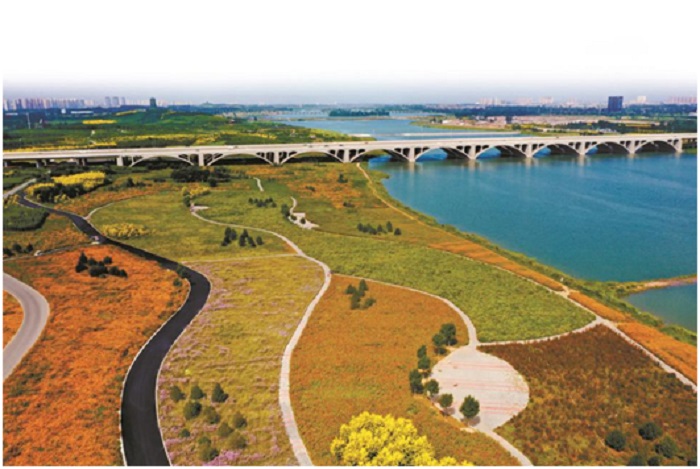



Hutuo River, the mother river of Shijiazhuang, capital of north China’s Hebei Province, witnessed significant improvement in its ecosystem in recent years thanks to local government’s ecological remediation efforts, recovering its charm and glittering again under the warm sunshine of the early spring.
The river, which runs 205 kilometers in Shijiangzhuang, crosses 10 counties and districts of the city. Ecological remediation projects revived the tributaries, wetlands, and lakes along the Hutuo River, and shaped a waterscape intertwined by multiple water environments.
As a result, the Shijiangzhuang section of the Hutuo River became an ideal habitat for wildlife, attracting flocks of rare birds. So far, more than 20 wild bird species, including egret, swan and wigeon have been spotted along the river course.
Fu Zhenguo, 57, lives on the north bank of the Hutuo River in Yangzhuang village near the township of Zhengding County under the administration of Shijiazhuang. The man told People’s Daily that the river nowadays always reminds him of his childhood when he and his friends swam and caught fish in it. “The villagers had to cross the river by boats at that time,” he said.
However, the river gradually dried up since the mid 1970s due to the reduced flow from upper streams and climate change. “At first, it was empty in the morning and the water came back at night. Later the river just gradually dried up,” Fu said.
Ever since, the river course turned sandy and was covered by sewage and trash.
To save the mother river, Shijiangzhuang launched comprehensive treatment plans, dredging the river course, building levees, and greening the riverside. In 2017, the city issued a 20.9-billion-yuan ($3.24 billion) investment program to restore the ecology of a 109-kilometer section downstream the Huangbizhuang reservoir. As a result, city parks were built along the subsections in downtown areas, offering diverse places of leisure activities for residents. Besides, Shijiazhuang also remediated the ecology in other subsections and worked to protect basic farmlands as a natural way to green the banks.
So far, the phase-1 and phase-2 projects of Hutuo River ecological remediation have been completed, forming 2147.5 hectares of water surface and 8,165.7 hectares of vegetation. The phase-3 project is scheduled to be finished this April.
During the National Day holiday last year, all 85 kilometers of restored riverbanks of the phase-1 and phase-2 projects were opened to tourists, forming a beautiful long corridor with a series of landmark scenic spots.
What guaranteed the successful restoration is sufficient capital. Shijiazhuang introduced innovative financing, employing public private partnership (PPP) mode as a solution to financing and management difficulties. The Hutuo River ecological restoration project was the first river treatment project run by the PPP mode in Shijiazhuang.
Besides, the city also utilized the water from upper-stream reservoirs and the reclaimed water from sewage treatment works along the river, to ensure sufficient static water supply.
“To guarantee the water quality, environmental protection departments blocked sewage discharge outlets of 10 enterprises and established eight sewage treatment works along the river,” said Kang Wenzhong, deputy director of a management office of the Hutuo River ecological restoration project. In addition, a monitor and control center is also monitoring the banks of the river to prevent sewage from entering the river course, he added.
“More birds are coming,” said Liang Yulong, a bird photographer whose cameras have recorded the ecological progress of the river. In recent years, the water of the river gradually turned green, and more and more bird species appeared in his photos, including herons, egrets, swans, wigeons and reed parrotbills, an extremely rare species.
Besides, arbors, shrubs and groundcovers that match local soil and climate are now planted along the riverbanks. “The gradual recovery of the ecosystem in the Hutuo River has played a vital role in adjusting urban microclimate, optimizing living environment and improving people’s living quality,” Kang remarked.


The Executive and members of the.


The Acting Director, FCT Directorate of.


President Bola Ahmed Tinubu has been.



Barely a month after resignation of.


An Abuja based Legal Practitioner, Osuagwu.



Convener of Equitable Remedy, Mrs. Magaret.


Contractors handling the contract for city.


Nigerian government may have concluded plans.


The Diplomatic Correspondents Association of Nigeria.


A rights group, “Follow Me Talk.
Leave a Comment